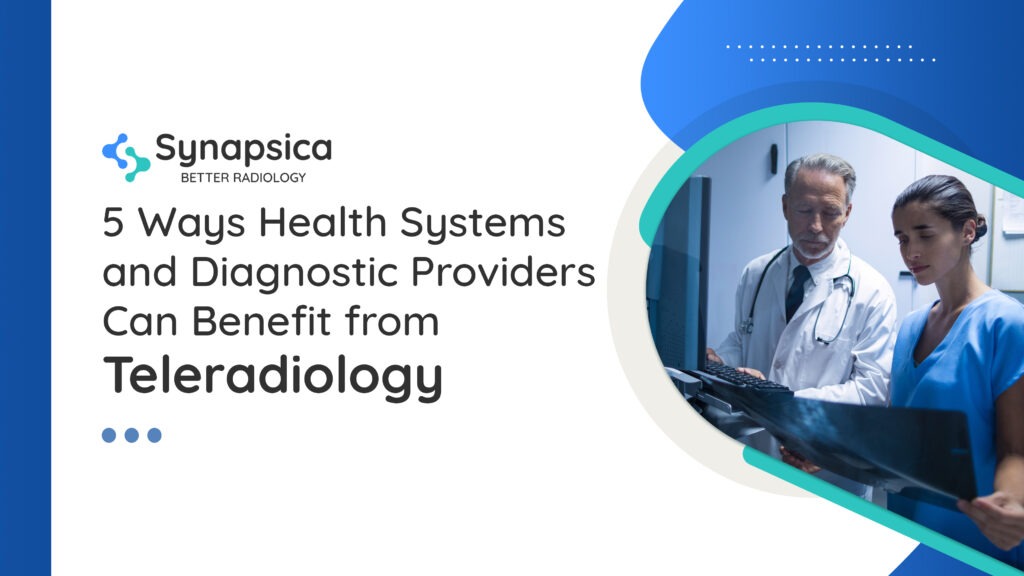
Radiologists’ workload has increased dramatically in the last decade. Today radiologists read 78% more cases than in 2008. The drastic increase in radiologist workload is majorly due to the increased number of cross-sectional imaging examinations, especially CT and MRI scans. In addition, the increased complexity of image interpretation due to larger datasets has amplified the workload of radiologists.
Technology has improved healthcare delivery and patient care enormously. Even then, healthcare providers and health systems were unable to find an affordable and appropriate solution to ease the workload for radiologists, until the advent of teleradiology.
While teleradiology didn’t make a great impact or impression during its initial days, today, particularly after the outbreak of the deadly contagion, COVID-19, teleradiology is becoming an integral part of radiology workflow in diagnostic centers and health systems.
This article talks about the ways healthcare providers can benefit from teleradiology.
5 Ways teleradiology will benefit healthcare providers
1. Efficient handling of case overload
Radiologists are so overworked today with the constantly growing pile of workload. The growing scarcity of radiologists is one of the major reasons radiology practices and professionals struggle to manage the increasing caseloads. But, the other important reason is the never-ending stack of medical images.
The increasing use of medical images in diagnosis has led to the dramatic increase of imaging data in healthcare. According to research, medical imaging data is likely to grow by 9X in the next nine years.
Increasing imaging data also means an increased workload for in-house radiologists. With the help of teleradiology, diagnostic centers and health systems can efficiently distribute cases to radiologists from other cities and other countries, reducing the workload of in-house radiologists.
2. Reduce in-house radiologist burnout
Fast-increasing imaging procedures and caseloads have led to radiologists working under tight time frames, resulting in increased work pressure. Also, radiologists do much more than just reading scans and creating reports.
Nearly two-thirds of radiologists’ time (33% to 65%) is consumed by non-reporting tasks like meetings, administration work, practical procedures, quality improvement projects, teaching practicing radiologists, etc.
Radiologists doing numerous tasks simultaneously in addition to studying medical images without having enough radiology resources has put them at a higher risk of burnout than other physicians. Burnout in radiologists has reportedly led to increasing diagnostic errors and reporting errors.
As teleradiology allows health systems to share caseloads with remote radiologists, the workload of in-house radiologists can be reduced dramatically. This also enables them to perform other non-reporting tasks efficiently without the risk of burnout.
3. Provide after-hour services
A radiologist’s job is not as easy as it seems. They have to work in shifts, 24/7 to provide appropriate patient care. But due to the growing shortage of radiologists, diagnostic centers are unable to work round-the-clock and provide the desired services at odd hours. This also increases their reporting TAT, eventually affecting their business credibility.
Teleradiology enables diagnostic centers to provide after-hour services even in the absence of in-house radiologists. With the help of teleradiology, diagnostic centers can take any case at any time and deliver reports quickly.
4. Save time and cost
One major benefit that diagnostic centers will realize with teleradiology is cost-cutting. Yes. Onboarding teleradiologists is much easier and cost-effective than hiring new in-house radiologists. By enabling radiologists to have immediate access to medical images via the internet, teleradiology eliminates the need to travel for radiologists and allows them to work from any remote location.
Also, teleradiology facilitates a win-win situation for both radiologists and diagnostic centers. As radiologists can work from any convenient location, even their homes, with teleradiology, diagnostic centers can save a good amount of operational costs.
5. Improve access to care in remote areas
It has always been a great challenge for healthcare providers to improve services and access to care in rural and resource-poor regions. But, teleradiology is changing this situation. Teleradiology’s potential is not limited to managing caseload and burnout in radiologists. It also has the potential to improve the delivery of healthcare services in areas having healthcare disparities or where they are likely to arise.
For example, ANMC (Alaska Native Medical Center), which is an acute, specialty, primary, and behavioral healthcare provider, provides comprehensive medical and diagnostic services through telehealth and teleradiology, as 60% of ANMC’s patients are from rural communities.
Summing Up
Though teleradiology dates back to 1947, it was unvalued for a long time. However, the advent of the COVID-19 pandemic and the dearth of radiologists have cast a new light on teleradiology and its applications. If not for teleradiology and telehealth, it would not have been possible for common people to avail medical assistance or seek professional help during the pandemic. And vice versa for healthcare providers.
Health systems and diagnostic providers who are using teleradiology services have reported reduced workload and burnout in radiologists and improved service and healthcare delivery for patients. They have also observed cost-saving and faster TAT after the use of teleradiology.
If you are looking to improve TAT cost-effectively, then Synapsica’s AI-powered teleradiology services are what you need.
Read 2X more cases at 1/3rd the cost with our AI-backed teleradiology service. Click on the image below to schedule a demo.

